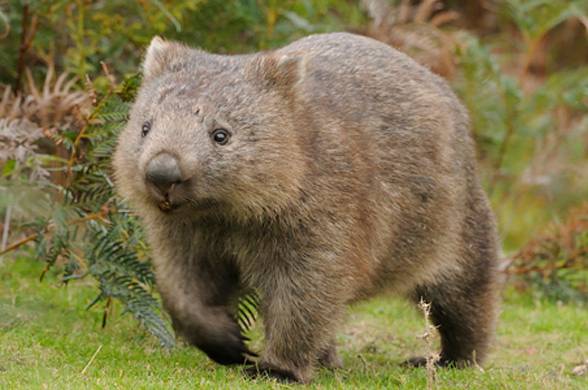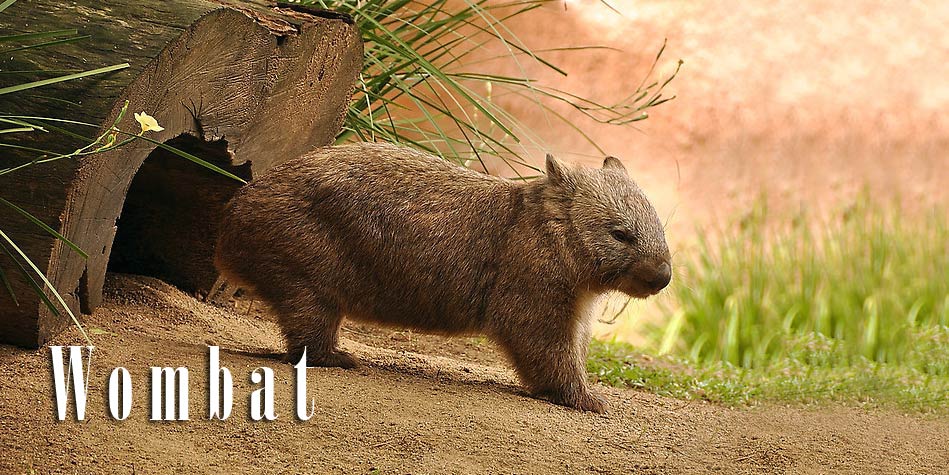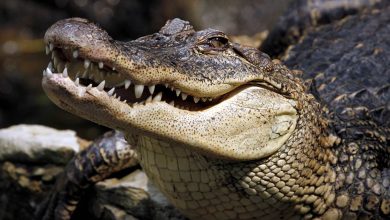Wombat – plump mammal
Wombats (Vombatidae) – plump marsupial
Wombat is next to short-beaked echidna and Tasmanian devils another representative of the original fauna of Australia and Tasmania. It is quite a massive but calm marsupial which, however, can fiercely defend itself in a dangerous situation. Interestingly, the animal has had its unofficial feast on the calendar since 2005 – named the Wombat Day.
Classification
- Kingdom: Animalia
- Phylum: Chordata
- Class: Mammalia
- Infraclass: Marsupialia
- Order: Diprotodontia
- Suborder: Vombatiformes
- Family: Vombatidae

Species and distribution
In the official classification, there are three species belonging to the wombats family. Two of them live solely in Australia and the third one also exists in Tasmania.
Wombats’ species
- the common wombat, coarse-haired wombat, bare-nosed wombat (Vombatus ursinus) – inhabits Tasmania and Australia from Queensland and New South Wales to the southeastern tip of the country – along the Victoria desert.
- the southern hairy-nosed wombat (Lasiorhinus latifrons) – occurs in southern and south-eastern Australia – from Nullarbor to New South Wales.
- the northern hairy-nosed wombat (Lasiorhinus krefftii) – it can only be found in central Queensland – at Epping Forest National Park. It is one of the rarest land mammals in the world and is critically endangered.
The natural habitat
The natural habitat of wombats depends on the species they belong to. The northern hairy-nosed wombat lives on dry and open areas, the southern hairy-nosed wombat additionally exists on savannas, steppes, forests and the brush, whereas the common wombat likes most terrains covered with hills and situated along forests.

Characteristic
All wombats species are animals, which are stubby built – they have got a very massive body and short legs, which makes the impression of being plump. As all marsupials, females have the breeding pouch with one pair of nipples, the entrance of which is placed is placed at the rump side. These animals’ heads are quite wide and their tails are vestigial. There are no fangs among wombats’ teeth.
Wombats have very long and powerful claws, which let them dig burrows constructed on the basis of interlinked rooms.
Their hair is quite thick and ranges in color from sandy, through brown and gray to black.

Diet
Wombats are herbivorous and their diet mainly consists of grasses, sedges, herbs, bark and roots. Their teeth resemble a little bit those of rodents, which are adapted to chewing hard plant material.
Wombats have an extremely slow metabolism – it takes them eight to fourteen days to complete the digestion process. Such a mechanism makes it easier for them to survive in difficult, dry climates.
Lifestyle
Wombat mainly leads a nocturnal lifestyle, and during the day rests in dug burrows. One individual can have up to ten burrows. Defending its territory and burrowing wombat can be very aggressive towards intruders.
The wombat usually moves in a slow and lazy way but in case of danger, it can reach the speed of 40 km/h (24 mph) and keep it for 90 seconds.
Wombats generally lead a lonely lifestyle – sometimes they form underground colonies with other wombats.

Reproduction and development
Wombat females, similarly to other marsupials, e.g. kangaroos, have the pouch in which the young stay for first months after birth.
Wombats are born in early spring and usually, one young is born. The pregnancy lasts only 20 – 21 days and the young is born vulnerable and poorly developed. It moves straight away to the female pouch, where it stays for the next 6-7 months. Then, it goes out for the first time independently but it is fed with mothers’ milk up to the age of 15 months. Wombats are sexually mature at the age of 18 months.
Wombats can live about 26 years in wild and even longer in captivity.

Wombats and people
Although wombats are usually quite gentle, they can attack people being provoked. There are cases of stab wounds made with claws as well as bites – – they give about 2-centimeter wounds despite wearing protective clothes such as rubber boots and woolen socks.
Wombats can be the real annoyance for farmers because they dig their burrows in fields and pastures. This results in excessive combating them, and the consequence is an increasingly decreasing population of wombats. People hunt these animals not only because they are wreckers but also for their meat, fur or simply for the sport.

Natural enemies
Wombats have several natural enemies, mainly foxes, dingos as well as Tasmanian devils. Animals are almost defenseless on the ground while the predator’s attack but when they hide in the burrow, they are almost completely safe as intruders have no access to them.
Protection
The northern hairy-nosed wombat is the most endangered species. Its population decreased drastically – up to 138 individuals in 2007 – because of excessive hunting, predators’ attacks, diseases and the necessity of competing for food, mainly because of the excessive grazing of domestic cattle.
There are two wombats’ species are not endangered – the exception is the population of the common wombat in Victoria.

Detailed information / size
All species of wombats have similar dimensions, which are as follows:
The common wombat (Vombatus ursinus)
- The length of the body: from 71 to 119 cm (28 – 47 in)
- Height at shoulders: from 25 to 30 cm (10 – 12 in)
- The length of the tail: around 2,5 cm (1 in)
- Weight: 15 to 36 kg (33 – 79)
The southern hairy-nosed wombat (Lasiorhinus latifrons)
- The length of the body: from 77,2 to 93,4 cm (30 – 37 in)
- The length of the tail: around 5 cm (2 in)
- Weight: 19 to 32 kg (42 – 71 lb)
The northern hairy-nosed wombat (Lasiorhinus krefftii)
- The length of the body: up to 100 cm (39 in)
- Height at shoulders: up to 35 cm (14 in)
- Weight: up to 40 kg (88 lb)
The wombats – curiosities
- The northern hairy-nosed wombat is endangered. Its total population is around 140 species including 30 mature females.
- There has been a new unofficial holiday in the calendar since 2005 – – Wombat Day established on October 22.
- 46 thousand years ago, Diprotodon – the largest marsupial in the history of the Earth – was extinct. Diprotodon had many common features with modern wombats.
- Wombat known as Patrick or ‘Paddy Cake was the largest wombat on earth, it weighed 38kg (84 lb).



















